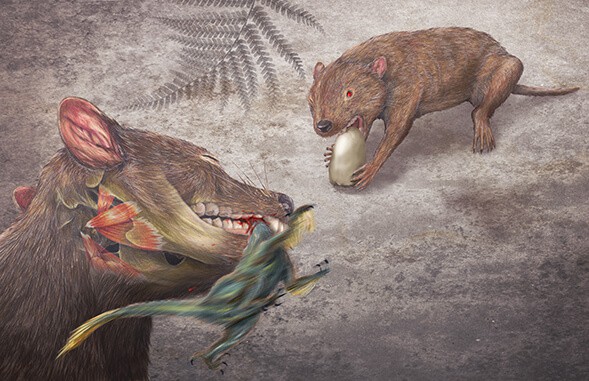Move over, hyenas and saber-toothed cats; scientists have discovered a mammal with an even stronger bite. San Diego State University biologist Eric Ekdale was part of a team of researchers who describe in a new study an early marsupial relative called Didelphodon vorax that lived alongside ferocious dinosaurs and had, pound-for-pound, the strongest bite force of any mammal ever recorded.
The team, led by paleontologists from the Burke Museum and the University of Washington, published their findings today in the journal Nature Communications. They suggest that mammals were more varied in size and behavior during the Age of Dinosaurs than previously believed. Didelphodon was able to eat a variety of foods, and was likely a scavenger-predator who could eat prey ranging from snails to small dinosaurs. Previous theories posit that marsupials originally arose in South America, but anatomical features of Didelphodon point to marsupials originating in North America some 10–20 million years earlier than previously thought, only later dispersing and diversifying in South America.
“What I love about Didelphodon vorax is that it crushes the classic mold of Mesozoic mammals,” said University of Washington biologist Gregory P. Wilson, Burke Museum adjunct curator of vertebrate paleontology. “Instead of a shrew-like mammal meekly scurrying into the shadows of dinosaurs, this badger-sized mammal would’ve been a fearsome predator on the Late Cretaceous landscape—even for some dinosaurs.”
All of these findings are made possible by four fossil specimens recently discovered in the 69–66 million-year-old deposits of the Hell Creek Formation in Montana and North Dakota. Prior to these discoveries, the 60 known species of metatherians (marsupials and their closest relatives) from the Cretaceous of North America—including Didelphodon —were almost all identified through fragments of jaw bones or teeth, providing a limited glimpse into marsupials’ closest relatives. These four fossils include a nearly-complete skull from the North Dakota Geological Survey State Fossil collection, a partial snout and an upper jaw bone from the Burke Museum’s collections, and another upper jaw from the Sierra College Natural History Museum.
With the help of Ekdale, who analyzed the evolutionary relationships and biomechanics of these fossils, the researchers were able to determine these marsupial relatives were about the size of today’s Virginia opossum. With a nearly complete skull to measure, they were able to estimate the overall size of Didelphodon, which ranged from 5.3–11.5 pounds.
To test the bite force of Didelphodon, the team CT-scanned the fossils and compared gaps in the reconstructed skulls—spaces where jaw muscles would go—to those of present-day mammals with known bite forces. These measurements indicate that pound-for-pound, Didelphodon had the strongest bite force of any mammal that has ever lived. Didelphodon’s canines were similar to living felines and hyenas, suggesting they could handle chomping into bone, biting deep and killing prey. Its shearing molars and big rounded premolars, combined with powerful jaws and jaw muscles indicate it had a specific niche in the food web as a predator or scavenger capable of crushing hard bone or shells, and was capable of eating prey as big as it was—even possibly small dinosaurs.
“There is a romantic view of the Age of the Dinosaurs with terrifying reptilian giants stomping across the landscape, while meek little mammal fur balls scurry in between the legs of the dinosaurs as they try to find insects to eat and hopefully not get trampled,” Ekdale said. “But Didelphodon changes that picture. This was no shrinking violet. It could hold its own in its ecosystem.”
If our reporting has informed or inspired you, please consider making a donation. Every contribution, no matter the size, empowers us to continue delivering accurate, engaging, and trustworthy science and medical news. Independent journalism requires time, effort, and resources—your support ensures we can keep uncovering the stories that matter most to you.
Join us in making knowledge accessible and impactful. Thank you for standing with us!

